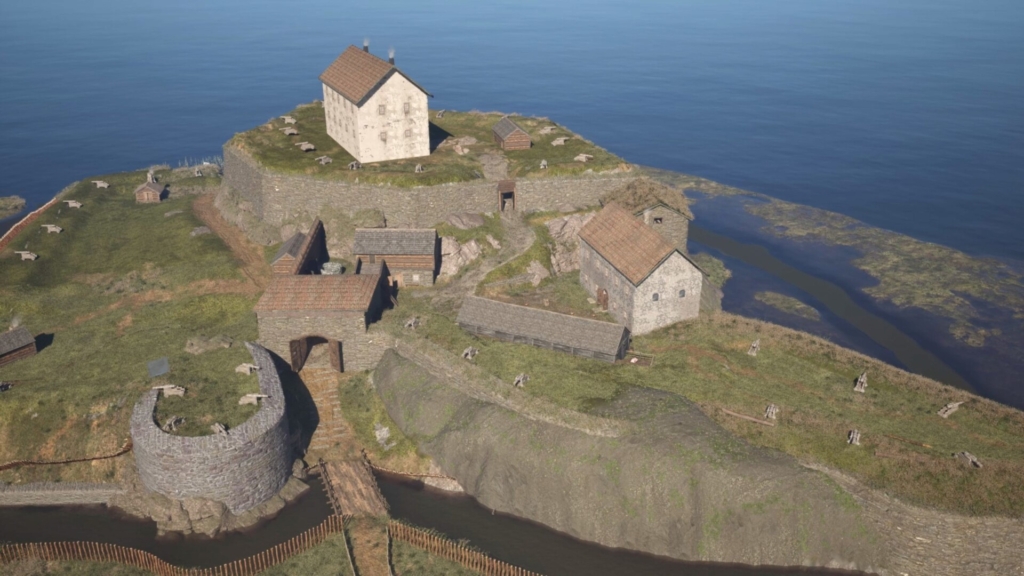This is the true story of Emerentia Pauli, wife of the commandant at Gullberg Fortress, Sweden, in 1612. When the Danes suddenly attacked, it was she who led the defense of the fortress after her husband was injured. It’s a part of the series of Women and War.
Night of January 25, 1612, Gullberg Fortress (modern-day Gothenburg).
Emerentia wakes up to a terrible crash. The walls of the bedroom shake. Beside her, her husband Mårten, the commandant of the fortress, leaps out of bed. He nearly collapses again but grabs his crutch and begins to half-hop, half-drag himself towards the door.
– The children! he shouts.
Emerentia jumps out of bed and runs into the chamber, grabs the children from their beds, and hurries with them to the bakehouse. Then she rushes up to the fortress walls. Her heart is pounding wildly in her chest.
At the top of the wall, chaos reigns. It’s hard to see in the dark, but she distinguishes ladders set against the walls and men climbing up them. But then she sees something else. The gate is blown open. It’s only a matter of time before the enemy breaks through.
Emerentia rushes towards it, shouting as loud as she can to be heard over the battle din. The breach in the gate must be blocked. She gathers a few soldiers and soldiers’ wives during her sprint, and soon they are busy placing barrels and carts in front of the gate.
Emerentia shouts out orders. Load the cannons! Boil the lye! Get reinforcements from the main fortress! The Danes are here!
We don’t know much about Emerentia’s background. She may have been the daughter of a priest in Nylöse, the small Swedish town that used to be where Gamlestan in Gothenburg is today. Gullberg Fortress, meant to protect the town from attackers, was also located there.
Emerentia lived there with her husband, Commandant Mårten Krakow, and their children. Mårten had lost one of his legs in a previous war injury. His position at Gullberg Fortress was supposed to be a lighter duty for him.

The fortress consisted of two parts: a main castle on the cliff and a smaller fort below. It was in this fort that the battle against the Danes took place. (This image is a reconstruction, link to source below)
Under the cover of darkness, the Danish soldiers had climbed up to the fort and blasted holes in the palisade and the gate. Mårten, with his injured leg, led the defense from inside the castle on horseback. However, he fell from his horse and broke his other leg. The one who came to lead the defense of Gullberg Fortress was his wife, Emerentia.
Her taking over the leadership and the soldiers obeying her indicates that she already had a prominent position and likely helped her husband manage the fortress. She gathered the soldiers’ wives and ordered them to block the gate and boil lye from ash and lime.
Then she gave the order to load the cannons with scrap metal. When the next wave of soldiers reached the gates, the lye was ready, and Emerentia had it poured down from the walls, scalding the men below.
Around 30 Danish soldiers had actually entered the fortress through the broken gates. Hungry as they were, they weren’t so interested in fighting, but instead ran to the bakehouse – where Emerentia’s children were. A maid placed there to watch them gave the soldiers bread. They seems to have stayed there while the battle raged outside, assuming their side was winning.
But so far, the fortress held firm. However, the gunpowder was exhausted, and no reinforcements came from the main castle, which had shut its gates, believing the fort was already lost.

But Emerentia had far from given up. She climbed up the cliff and shouted to the gatekeepers that if the fort fell and the defenders died because they didn’t receive gunpowder, everyone in the main fortress would be hanged. This persuaded them to open the gate and share their gunpowder.
Thus, the defenders managed to hold the fort through the night. By dawn, the attackers lay in heaps outside the walls, shot or scalded by the lye Emerentia had ordered. Despite the victory, she was furious that the commander of the main fortress, Sven Ramnköv, had closed the gates and refused to come to their aid.
It is said she stormed into the fortress and confronted Sven while he was in the privy. She berated him severely and then grabbed his feet, tipping him backward into the refuse.
What about the 30 soldiers in the bakehouse? They had finally realized that the battle were lost, and wanted to negotiate. Once again though, they simply wanted to eat. Emerentia promised them more food if they surrendered. One by one they were allowed outside, and then killed – as quietly as possible so as not to arouse the suspicions of the men who remained in the bakehouse.
This suggests that either there were very few defenders left alive, so that even 30 enemies would be a problem – or that the Danish soldiers held Emerentia’s children as hostages inside. Or both.
Whichever was the case, all but one of the Danes were killed. The last one was probably spared to be interrogated about the Danish war effort.
Emerentia’s husband, Mårten, was transferred to Vaxholm Fortress, a more significant defense installation in the Stockholm archipelago, and the family followed. Just a few months later, in May 1612, the Danes attacked again and captured both Älvsborg Fortress and Gullberg Fortress.
After Mårten’s death, Emerentia moved back to the region, then once again under Swedish control. Here, the city of Gothenburg began to be built, and where Gullberg Fortress once stood, a new fortress, Skansen Lejonet, was erected.

It still stands today, and the road leading up to it is named Emerentias Backe (Emerentia’s Slope).
Source:
Högberg, Stefan. Svenska kvinnor historien glömde. (2019)
The reconstructed image of Gullberg’s fortress was made by Arkeologerna.

